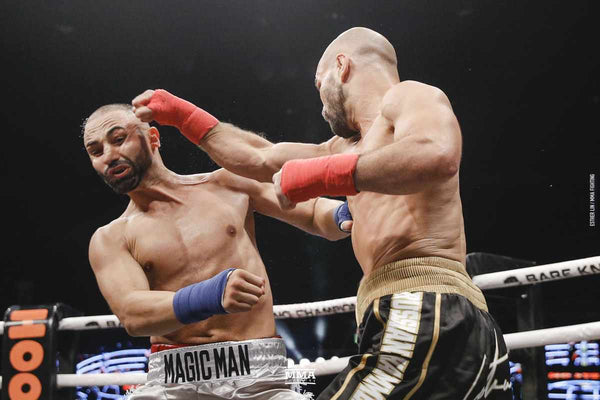
On June 22, 2019, Artem Lobov (13-15, MMA), an MMA journeyman managed to edge out former 2-division World Champion professional boxer Paulie Malignaggi (36-8, Boxing) in a bare-knuckle boxing match at Bare Knuckle Fighting Championship 6: Malignaggi vs. Lobov.
The unexpected result sent shockwaves throughout the combat sports world and “exposed” the sport of boxing.
Many believed that because a typical MMA fighter (like Lobov) has to cross-train in so many different disciplines, that once they met someone who only trained one striking martial art (in this case - Malignaggi with his boxing) - that the MMA fighter would be exposed as an inferior striker when matched with a real specialist.
But Lobov made most of his damage count while in the clinch, landing dirty boxing shots and cutting Malignaggi up with his punches.
The “hole” that was exposed in the sport of boxing was not so much that boxing was ineffective as a striking art, but that real-life boxing, as a martial art (without gloves on), turned out to be so much different than regular boxing training and sparring (with gloves on), that it immediately begged the question if boxing was even useful in real life at all (and not inside the sporting ring).
“I've broken my hand several times, I'm pretty sure when I threw that jab to the stomach and right hand to the head in Round 2, I'm pretty sure my right hand is broken. I felt a pain that I'm pretty familiar with." Malignaggi said.
In this blog post, we will look at the elements of boxing without gloves on, and if that means boxing training is, to some people who define it as such, the new "Kung Fu" (referring to a martial art or system that is only effective in its own ecosystem but ineffective once it is applied to the reality of fighting).
The Differences Between Gloves vs. No Gloves
For the longest time in combat sports, many pundits and people who trained believed that without a doubt, western boxing or “the sweet science” was one of the most effective, tried and tested, refined, and advanced forms of striking one could ever learn and add to their striking arsenal.
That was until June of 2019 when the discipline of boxing went up against an MMA striker in a match many thought was going to be won by the boxer. (The Russian, Lobov, was 1-0 in his bare-knuckle boxing career and was a +180 underdog with the New York native, Malignaggi, coming back at -220.)
With the triumph of the journeyman MMA fighter against a championship-level boxer in a bare-knuckle rules boxing match, professional “championship-level” boxing techniques were proven to be not that much better or effective than the striking techniques of an average boxer or MMA fighter - once the gloves came off (literally).
Chael Sonnen sounds off on if boxing is really a joke of a sport. He states that it would never happen in any other sport, especially the sport of wrestling, where a World Champion would lose to a random athlete that wins through pure toughness and tenacity.
Without the use of boxing gloves, or “pillows” as they are alternatively referred to, made the match play out differently than what most people expected.
Let’s look at what changed between wearing gloves and not wearing gloves in a striking contest.

Dynasty's Dueling Dragons Boxing Gloves
With Gloves:
- You can shield and block yourself from punches by holding your boxing guard up.
- You can hit the other person with your “pillow” fists that have a much larger surface area, and a higher chance to land blows as a result.
- Because your hands are protected by the gloves and hand wraps, you can swing with full-body (feet, hips, shoulders, arms) power without worrying about breaking your own hands.
- Gloves make your hands close-fisted, so there are fewer attacks to worry about as you can’t grab each other’s hands, neck, body, or clinch.
- Less accuracy is needed when throwing punches with big gloves. As long as you land on target with enough power, the force of the blow will do damage regardless if the shot was to the temple, face, or chin.
Without Gloves:
- You can’t shield yourself as much from blows, as your hands and wrists suddenly become too small to block shots that you were used to blocking. Punches and strikes start slipping through your guard.
- You can’t hit the other person as easily, as your hands have become a lot smaller. The accuracy of your punches plummets, as shots you used to land with your “pillows” now hit nothing but thin air, or hit off target as they become grazing or glancing blows.
- You can’t throw with reckless power, because without gloves and hand wraps, you’ll break your delicate hands on a person’s skull, shoulder, or elbow. All of a sudden, wild power shots become risky to throw, and a higher focus is placed on dirty boxing, clinch work, “slap” boxing, or open-handed attacks.
- Open palms mean you have to worry about much more than just punches - now there’s finger jabs, palm strikes, elbows, and hand fighting / grabbing / clinching to the arms, neck, and body.
- More accuracy, movement, and skill is required, to land the perfect shot to the nose or chin in order to do damage. If you end up punching someone’s forehead or skull, your hands are more likely to shatter than their head would.
Because so much of boxing training and fighting is done wearing the gloves, the performance of Malignaggi brought realistic concerns to boxing’s application on the street.
Not So Fast… Boxing Isn’t “Useless” On The Street
OK - maybe claiming boxing is “useless” in a real fight is taking it too far.
This classic video is a great example of a person clearly trained in boxing, using an effective jab to drill incoming attackers away.
However, what is becoming more apparent through this analysis is that the differences are still significant enough between boxing training and the actual application of boxing punches on the street, that the techniques you learn to use have to be modified in order for them to remain effective.
What are the attacks from boxing, without gloves on, that can still be used then?
- The Jab. A good clean jab doesn’t need that much power and can knock attackers back and down with the right accurate placement and timing. Don't jab hard to the body, however, as the body weight of your opponent will prove to be too much for your wrist to handle.
-
The back-fist or backhanded slap. A back fist, either thrown from a static position or as a back-handed strike after a miss on a hook or spinning back fist is relatively safer to throw than a full-on over-hand right or hook punch, provided you don’t miss and break your own forearm on the other person’s head.
The static back fist is safe to throw because it is a low-commitment move, you’re hitting someone with a whip-like motion that if met with strong resistance, only snaps your wrist back the other way instead of breaking your hand.
- The short straight punch or reverse punch. While taught in other martial arts and not exclusive to boxing, a straight punch down the middle can still be thrown with lesser chance to break your hand, provided it is thrown internally (no wind-up) from the feet and hips and lands on the face or chin, and not the top of their head.
-
The short hook. Without swinging for the fences, the short hook can still be effective provided you are throwing it more like a slap or a “whip” rather than with your entire body weight, keeping your hand a little looser and letting the “snap” of the wrist do the work (not your forearm bone).
The idea here is you just need enough force to clip someone on the chin, you’re not looking for a heavyweight knockout blow.
-
The uppercut. Uppercuts, especially from the single collar tie / dirty boxing clinch, is very effective on the street and can be thrown with low risk as it will almost always hit someone’s chin or face, instead of the top or side of the head where the hand is most susceptible to break over.
- Selective body shots. As long as you hit them in the solar plexus or around the floating rib (left side liver shot), your hands should be safe from damage. Avoid the stomach (fat / muscle will protect the impact) and the elbows.
Techniques that become much riskier to throw, or downright obsolete:
- Overhand right. You’re risking to land hand first at an awkward angle on top of someone’s skull, temple, or miss and hit their shoulder. All resulting in damaging your own hand.
- Any full power hook aimed at the head. Even if you actually manage to hit them in the face, their cheekbones are still quite sturdy. You’re more likely to hit someone’s temple or glance past the side of their head and hurt your hand.
- Any closed-fist strike at full body commitment with 100% power. Too much force will just break the delicate bones in your hands and damage your wrists, period.
All this talk of bare-knuckle, open-handed fighting brings back memories of Bas Rutten’s PANCRASE days, doesn’t it?
Is Modern Boxing Training Flawed For Real Life?
As we all know, in real life we don’t suddenly start fights or start defending ourselves with 16oz “pillows” on our fists. We punch, kick, strike, and block bare-knuckle or with open hands.
Now, consider the following for just a second.
If: “boxing without gloves” makes boxing (mostly) useless (or at least presents an entirely different scenario to deal with)...
Then: Is it fair to say that boxing with gloves against other boxers with gloves just equals a fighting style, system, or “sport” that is only effective against others willing to engage in this same style, system or “sport”?
Wait a minute. Where have we heard this observation before?
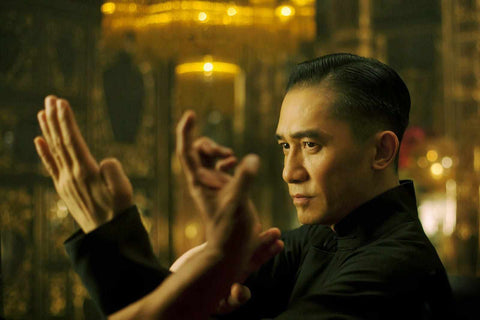
That sounds exactly like what most people describe Kung Fu, doesn’t it?
Kung Fu styles are largely looked down upon by modern combat sports experts as outdated, removed from reality, and only useful when used against other Kung Fu styles, or against people with little to no training.
Many say Kung Fu is “useless” - once it is pitted against a wrestler or a Brazilian Jiu-Jitsu (BJJ) grappler. Once it is used outside of their own ecosystem of rules and beliefs, Kung Fu is “fantasy fighting”.
Side Note: But isn’t boxing equally useless against a kickboxer, wrestler or BJJ grappler anyway? It’s not like boxing has any defense towards grappling or kicks. The same can be said for wrestling or BJJ as well, they’re all equally defenseless against people who can strike and avoid being taken down, and so on and so forth...
But what about boxing? Is “boxing with gloves” useless as well? A “fantasy sport”?
Since Artem beat Paulie - doesn’t this mean “Boxing” is the new “Kung Fu”?
To take this train of thought even a step further, wouldn’t it be more effective if we just skipped the gloves and flat out learned to strike empty-handed?
Empty-handed street boxing? Where can I learn that?
Wait a minute. Training to strike effectively in real life, using just your bare hands?
That again sounds awfully familiar to an ecosystem of martial arts that have been pretty much written off by the combat sports world as ineffective in modern-day fighting or in real life…

Yes - you guessed it, we’re talking about Kung Fu.
(And to some extent - all other empty-hand “traditional” martial arts that fall outside of what is considered a part of the modern combat sports hemisphere, like Karate, Taekwondo, etc.)
But more specifically, we’re referring to a specific style of Kung Fu that was designed to be simple, efficient, learned quickly and fully applicable to street fighting.
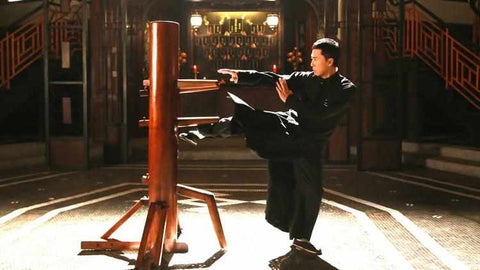
We’re talking about Wing Chun Kung Fu, Bruce Lee’s original base martial art and the same martial art taught to him by Grandmaster Ip Man.
Bare-Knuckle Fighting or Wing Chun Kung Fu?
Why Wing Chun Kung Fu specifically?
Because when we look at the techniques the style specializes in, we start to see many “bare-knuckle boxing” techniques, or street effective techniques Wing Chun is good for.
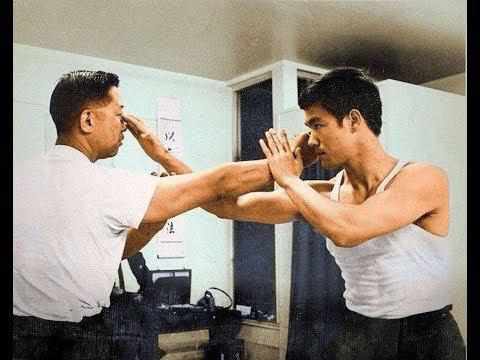
If “street efficiency” is what we are aiming for in empty-handed combat, then we should look no further than to utilize Wing Chun techniques to add to our “bare-knuckle boxing” techniques:
-
The Jab, Back Fist, or vertical Chain Punch / Straight Blast "Jik Chung" are core techniques in Wing Chun. All of these techniques are launched from an internal, short, close-range position that uses the torque of the hips, arms, forearms, and wrists to generate power. You won’t break your hand throwing punches this way.
- The Palm Strike / Slap. There are a lot of open-handed techniques in Wing Chun including palm strikes or repeated slaps to the head, face, and body. It seems silly in theory, but it won't break your hands in real life and you can do it 1,000 times over and over again.

-
Elbows. Elbow strikes and blocks from the sticky hands “Chi Sau / Sao” "Bong Sau / Sao" / clinch / dirty boxing position is great for street fighting. Your elbows are much stronger than your hands so you don’t have to fear breaking them. Tony Ferguson has used this in MMA.
- Fingers. Wing Chun teaches launching finger jabs "Biu Jee" and strikes from the short-range position or the clinch. Jon Jones has used this in MMA with great success, despite eye-gouging being illegal.
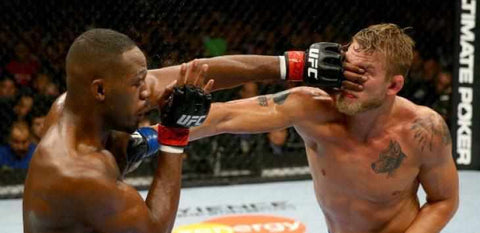
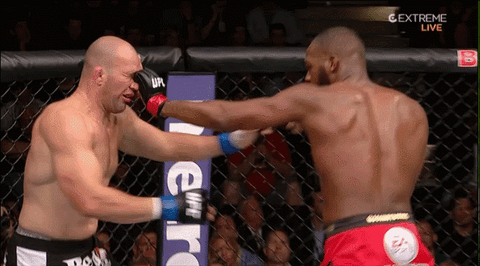
-
“Sticky Hands” or Hand Trapping. One of the most underrated and underutilized techniques in MMA or boxing is actually the battle of hand trapping or hand fighting.
If you control your opponents’ hands then he cannot hurt you. If you keep one hand out to grab or parry away your opponents' strikes or intercept them every time they try to strike you, then you are in control of the fight.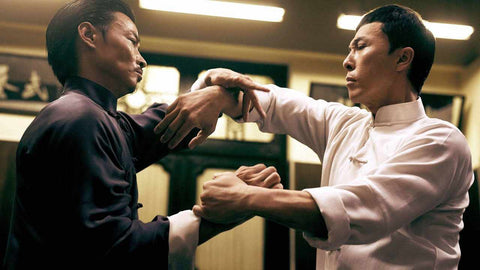
Some of the highest level strikers and wrestlers in combat sports such as Daniel Cormier, Anderson Silva, Lyoto Machida, Conor McGregor, Chris Weidman, Yoel Romero, and Jon Jones often hand trap or hand fight their opponents for superior control.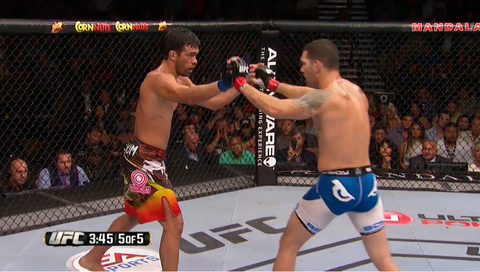
- Short kicks, side-kicks, and stomps. Jon Jones has mastered these kicks, also known as “oblique kicks”, aimed at the thigh or knee for maximum crippling damage with minimal effort.
But didn’t we already establish that Kung Fu effectiveness is highly exaggerated?
Yes, we have. Several times, in fact.
One time here when we looked at Bruce Lee, the evolution of his Wing Chun techniques and why overtime he transitioned to Boxing.
Another time we looked at why there was a lack of Chinese fighters in MMA, and one of those factors was that it was due to their belief in old Kung Fu techniques still being relevant in today’s combat sports landscape.
When we look at Kung Fu from a combat sports lens, in many ways Wing Chun Kung Fu is seen as and written off as physically weak, lacks real knockout power, and perpetuates outdated training methods that don’t adapt to modern-day training or fighting methods:
-
Emphasis on theory and techniques, but not enough real live sparring to actually apply the techniques or adapt those techniques against other styles or resisting opponents.
-
Lack of use of protective gear, therefore not enough real full contact sparring occurs to actually test techniques against other techniques in a fight.
- Lack of use of external, modern strength conditioning training as part of their martial arts curriculum and over-reliance on internal conditioning, creating a big gap in raw athleticism and knockout power.
All of this is true.
It is obvious that if you train your Kung Fu only to be proficient in defending against other styles of Kung Fu in a fighting landscape from 100 years ago, you’re going to be pummeled by today’s fighters.
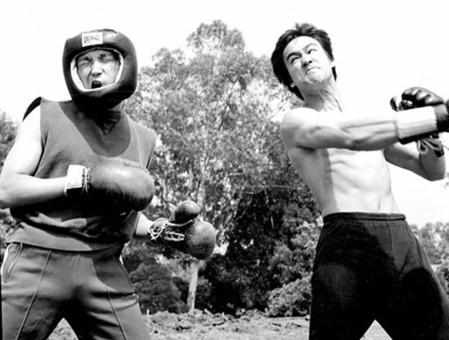
But what about boxing?
From a street fighting lens, what is seen as strengths in boxing becomes its weaknesses (and what is seen as weaknesses in Kung Fu becomes their strengths).
Boxing, while amazing for combat sports, can be seen as a “game” in a real fighting scenario and has its own shortcomings:
-
Emphasis on hitting pads, heavy bags, speed bags, and lots of sparring but with big gloves and not bare-knuckled. This creates a false sense of security because you're not hitting hard objects bone-to-bone, only soft targets.
-
Use of protective gear in live sparring means one can rack up a lot of good experience moving and throwing punches but not actually able to apply the same techniques at a 1:1 ratio to the empty-handed bare-knuckle fighting environment. Use of head gear also creates a bigger imaginary target.
-
Use of external conditioning training like resistance training, weights, and cardio, but very little internal conditioning of the fist, wrist, forearms, bones, and skin that Kung Fu conditioning training requires.
- No training for alternative, open-hand attacks like grabbing, clinching, trapping, or attacks to the flesh or bones.
The result of all this is that your best weapons (your hands) in boxing are actually greatly weakened in real life.
Respected martial arts actor and Karateka, Michael Jai White explains it better than we can in this video where he breaks down why throwing a real-life power punch is different than a boxing punch.
Michael Jai White concurs with us that the strongest punch uses the internal force from your body, with the feet, hips, and forearm moving together in one motion into a straight line "arrow". A strong fist, wrist, and forearm is required - something Kung Fu (or in his case, Karate - which was derived from Kung Fu, by the way) training provides the conditioning for.
Solution: Why Not Train Both?
The relationship between Boxing and Wing Chun is closer than you may think.
Both arts prioritize striking with the hands.
Boxing emphasizes footwork, movement, speed, and power.
Wing Chun emphasizes sensitivity, structure, and overwhelming forward pressure.
It is like looking at a mirror, or two sides of the same coin.
What is good in Boxing can also be bad in Boxing. What is good in Kung Fu can also be bad in Kung Fu.
The Yin and the Yang. Soft and Hard.
Box a brawler. Brawl a boxer.
Or perhaps, in this case, it’s Kung Fu a Boxer, and Box a Kung Fu-er.
If we look at the weaknesses of Kung Fu, we see these are strengths in Boxing.
If we look at the weaknesses in Boxing, we see these are strengths in Kung Fu.
So why not train both?

If you're going to start your Kung Fu journey, do it in style with one of our Neo Dynasty Retro Kung Fu jackets...

...or check out our Wing Chun Kung Fu collection!
The Pros Do It
UFC Interim Lightweight Champion Tony Ferguson is open about his Wing Chun Kung Fu training. He is arguably the first UFC / MMA fighter to recognize and utilize Wing Chun Kung Fu techniques inside the MMA cage / octagon, and admit to training in the martial art on camera.
UFC Light Heavyweight Champion and one of the greatest fighters of all time, Jon Jones, is a master of the Wing Chun foot stomp / side kick - or as Joe Rogan dubbed it, the "oblique kick".
Former UFC Middleweight Champion and again, one of the greatest fighters of all time, Anderson Silva, openly says Bruce Lee is his idol and uses hand trapping / elbow blocking “Bong Sau” Wing Chun techniques as a part of his striking arsenal.
Who are we to argue Wing Chun Kung Fu doesn’t work, when great combat sports athletes like these fighters are able to apply Wing Chun to their fight game?
The Legend of the Slap-Boxing Master is born

Nate Diaz, 10th-degree red belt in the ancient art of street slap-boxing.
In summary, the solution is then, to blend both traditional and modern techniques together into your training.
If you and your opponent know the exact same styles and techniques and cancel each other out, then simply put, the person who knows something the other doesn’t will have the advantage.
Train everything.
Be in good enough “external” shape and conditioning to be effective in a sports fighting environment. Overwhelm opponents in the ring who lack the conditioning, skill, and technique to keep up.
But also remember to train yourself in “internal” shape and conditioning such as your skin, your bones, and to be aware of the limitations of sports fighting techniques. Train your techniques to be lethally effective on the streets and in real life, not just for scoring points in a game.
You wouldn’t pull guard in real life on asphalt to get kicked in by multiple attackers, therefore you probably shouldn’t punch full force with a poorly conditioned, bare-knuckle fist either.
Train in the ancient ways of street slap-boxing, instead, young grasshopper.
Or just "Be Water, My Friend" - Bruce Lee.
- Dynasty Team







Comments
Boy did you blow the results of that fight out of proportion. Who knows what was going on in Pauline maliblahs ecosystem at that time. How he trained or if he trained, or if he has a drug problem or whatever the fuck. Anyway We’ve seen three mma champs lose to Jake Paul since then. 🤣
The boxing vs MMA fights show the strength of boxing—boxing is simple to learn and be effective with. So if you take two people with similar levels of ‘fight’ in them, one with two years of part-time boxing experience is just as effective as the one with 15 years of full-time boxing experience. That’s exactly what I would expect in any skill domain with four moves to learn.
Excellent article… I have been working on my own style and it is involved in so many different ways is the years have gone by… I was looking into boxing… But learning to use it as the old bare-knuckle boxers did it like Jim Driscoll our bill Driscoll I can’t remember his name and Dempsey… And yes the Bruce Lee punches look so solid and fast and efficient… The vertical and 45 degree punch is got a lot of speed and Power… Now I’m looking into Wing Chun with their low kicks stomp kicks oblique kicks front kicks and yes a good medium sidekick… Boxing footwork using JKD or Wing Chun or bare knuckle boxing from the past… With modern boxing head movement and footwork… I think this would be a really good Style… And your article has inspired me to dig into Wing Chun four advantages in boxing… I want my art to effective for self-defense and Sport so that their consistency and techniques… Thank you very much this article I could read it over a hundred times hey babe. You have very good points… Like to see more of your work – John
This is a good article but I just have to point out that just because Paulie lost doesn’t mean that showed boxing is not as effective as was once thought. Yes Paulie was a champion but he was never a hard hitting punching he won fights mostly with his evasive movements winning on points. If a boxer that was more of a hard hitter would’ve fought lobov we would be having a different discussion let alone any one of the current champions at that weight like Pacquiao Spence etc. I understand lobov was a journeyman but Paulie was never known to hurt his opponents and lobov most likely hit harder then Paulie
Great indepth analysis! Diveristy in training is the best, keeps you guessing and your body ready for anything.
Its almost as if each sport caters/restricts the techniques that can be used, and that athletes can expect those techniques to be used in those specific contexts 🤔